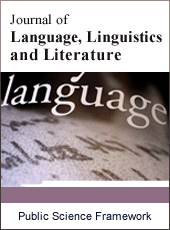Journal of Language, Linguistics and Literature
Articles Information
Journal of Language, Linguistics and Literature, Vol.3, No.1, Feb. 2017, Pub. Date: Dec. 21, 2017
Syntactic Errors Arab Learners Commit in Writing
Pages: 1-7 Views: 3140 Downloads: 4386
[01]
Ruba Ahmad Mustafa, Department of English Language and Literature, Faculty of Arts, Jubail University Collage, Jubail, KSA.
This study tackles the issue of the common syntactic errors that Arab learners’ might encounter in the written form of language while using English as a second language. It aims to identify the most common syntactic errors in the writing of Arab learners. It also attempts to discover the reasons behind these problems. This research is conducted on a sample of prep-year students of Jubail University College. The methods used in this study are descriptive and analytic. Several questionnaires were handed to the prep year teachers who noticed these errors while they teach and mark portfolios. The major findings of this study were that the types of errors were classified differently according to different teachers although they follow the same rubric, and that the students actuate their previous linguistic knowledge in transferring a language to another, so they transfer from their first language to the second language. Some suggestions by teachers were listed to aid second language learners in writing. The reasons why punctuation marks are considered a weakness point for the students.
Syntactic Errors, Arab Learners, Writing
[01]
Akande, A. T. (2001) “Learners Competence versus Morphological Appropriateness in the Acquisition of English.” Ife Studies in English Language 5: 36-45.
[02]
Al-Buainain, H. (2007). Researching Types and Causes of Errors in Arabic Speakers' Writing. Midraj, S. Jendli, A &Sellami (Eds.), Research in ELT Context (195-224). UAE.
[03]
Al-Gharabally, M .(2015). The Writing Difficulties Faced by L2 Learners and How to Minimize them. International Journal of English Language and Linguistics Research, 3(5), 42-49.
[04]
Babalola, E. T. and Akande, A. T. (2002). “Some Linguistic Problems of Yoruba Learners of English in Nigeria” ES: Revista de Filologia Inglesa 24: 245-257.
[05]
Cook, V. (1992) “Evidence for multi-competence Language learning,” vol. 42, no. 4, pp. 557-591.
[06]
Dulay, H., Burt, M., and Krashen, S (1982). Language two, Oxford: Oxford University press.
[07]
Meehan, S. (2013). An Investigation into the Structural Errors of Arabic Learners’ Written Persuasive Discourse in English (MA). University of Lancashire.
[08]
Ngangbam, H. (2016), An Analysis Of Syntactic Errors Committed By Students Of English Language Class In The Written Composition Of Mutah University: A Case Study, European Journal Of English Language, Linguistics and Literature, 3(1).
[09]
Odlin, T. (1989). Language transfer: Cross-linguistic influence in language learning.
[10]
Selinker, T. (1992). Rediscovering interlanguage, London: Longman.

ISSN Print: 2381-7054
ISSN Online: 2381-7062
Current Issue:
Vol. 6, Issue 1, March Submit a Manuscript Join Editorial Board Join Reviewer Team
ISSN Online: 2381-7062
Current Issue:
Vol. 6, Issue 1, March Submit a Manuscript Join Editorial Board Join Reviewer Team
| About This Journal |
| All Issues |
| Open Access |
| Indexing |
| Payment Information |
| Author Guidelines |
| Review Process |
| Publication Ethics |
| Editorial Board |
| Peer Reviewers |


